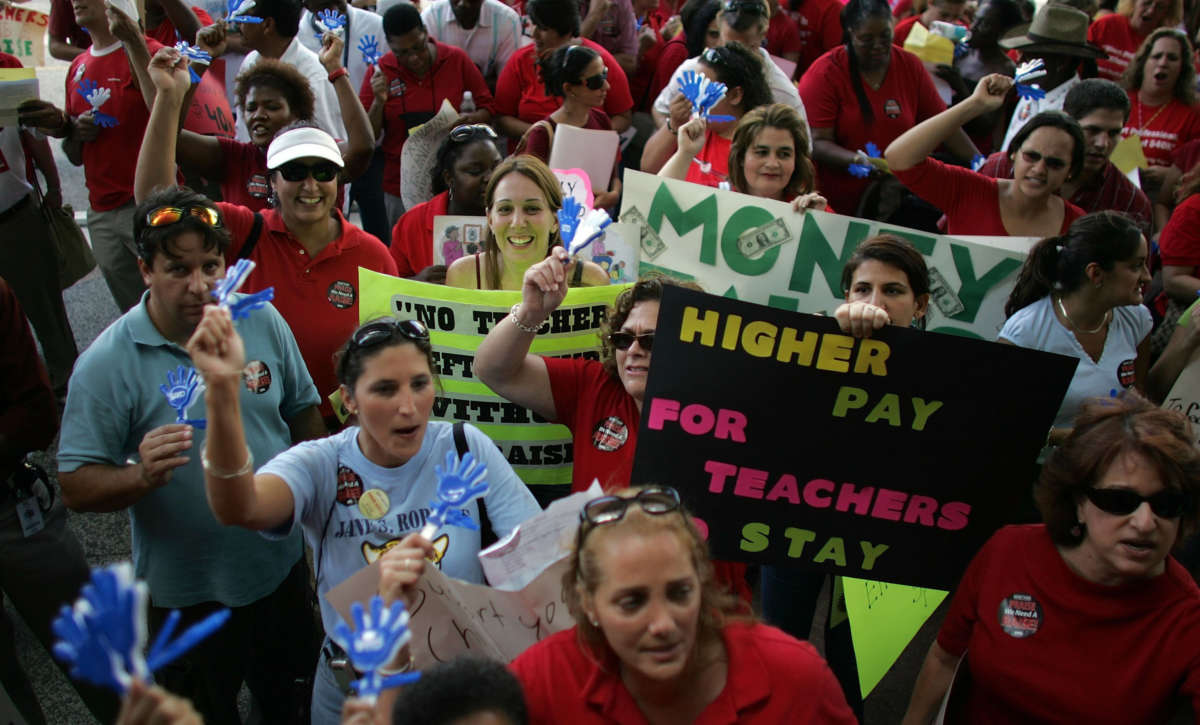Amid reports of teacher shortages across the U.S. numbering in the hundreds of thousands, along with violent and vicious far-right attacks on public schools, new research shows that teacher salaries are now at record lows.
A report published by the Economic Policy Institute (EPI) on Tuesday finds that, while there has long been a pay gap between teachers and comparable college graduates, that gap has recently reached its highest level since EPI began recording such data.
In 2021, the report found, teachers’ weekly pay was 23.5 percent less on average than that of other college graduates, adjusted for age, education, race and state of residence. This means that teachers made about 76 cents on the dollar compared to other college graduates.
The report notes that this pay gap has been growing larger since the mid-1990s, when it reached a low of only about 5.1 percent in 1993 before it began rapidly worsening throughout the rest of the decade. Colorado, Oklahoma, Virginia, Arizona and Alabama have the highest teacher pay gaps, with teachers making 30 percent less than their college-educated non-teaching peers. There are no states in which teachers make as much as or more than their peers.
Even when adjusted for benefits, teachers were still paid drastically less than other college graduates. With benefits like retirement packages and health care included, teachers’ overall compensation was still 14.2 percent lower than that of their peers.
The supposed benefit of having summer vacations off of work don’t offset the pay penalties, either; EPI found in a similar report in 2019 that teachers still work comparable hours on a weekly basis, noting that many teachers still attend trainings and conferences during the summer.
This pay deficit could help explain the current teacher shortage. The National Education Association, the largest teachers union in the U.S., estimates that there is a shortage of nearly 300,000 teachers and support staff across the country. This is not only a crisis for public schools, but also for families and students, who may suffer from an understaffed education system. The shortage will also place new pressures on teachers, who were already highly demoralized and put in danger by the pandemic.
Escalating right-wing attacks on teachers may also help to explain the shortage, as the far right doxes teachers and sends them death threats over actions like teaching the country’s history of racism or refusing to discriminate against LGBTQ children.
Conservative lawmakers are also largely behind threats to public school teachers’ pay. As EPI analysts wrote in 2019, shrinking teacher wages are “the result of revenue declines states brought on themselves by cutting tax rates.” For instance, a 2016 report cited by the authors found that half of states were providing less funding for grade schools in 2016 than they were before the recession, adjusted for inflation.
In recent years, low wages have spurred teachers to wage strikes across the country; 2018 and 2019 saw a huge wave in teachers’ strikes, including a strike in Oklahoma in which roughly 30,000 teachers striked for over a week, closing nearly half of the state’s school districts. Teachers in multiple states have continued those strikes this year, with thousands of teachers walking off the job in protest of severe shortages, low pay and burnout.
EPI writes that the only way to remedy teacher pay deficits is to take “targeted and significant policy action — not just on teacher pay but on school funding more generally,” and emphasize that the pay gap plays a large role in discouraging teachers from keeping their jobs and college graduates from becoming teachers.
“This report again sounds the alarm on the long erosion in relative teacher wages and the widening gap in total compensation,” the author wrote, “which makes the prospects for attracting and retaining the teachers needed to alleviate shortages difficult at best.”
Defying Trump’s right-wing agenda from Day One
Inauguration Day is coming up soon, and at Truthout, we plan to defy Trump’s right-wing agenda from Day One.
Looking to the first year of Trump’s presidency, we know that the most vulnerable among us will be harmed. Militarized policing in U.S. cities and at the borders will intensify. The climate crisis will deteriorate further. The erosion of free speech has already begun, and we anticipate more attacks on journalism.
It will be a terrifying four years to produce social justice-driven journalism. But we’re not falling to despair, because we know there are reasons to believe in our collective power.
The stories we publish at Truthout are part of the antidote to creeping authoritarianism. And this year, we promise we will kick into an even higher gear to give you truthful news that cuts against the disinformation, vitriol, hate and violence. We promise to publish analyses that will serve the needs of the movements we all rely on to survive the next four years, and even build for the future. We promise to be responsive, to recognize you as members of our community with a vital stake and voice in this work.
Please show your support for Truthout with a tax-deductible donation (either once today or on a monthly basis).
